One thing no engine builder wants to worry about is a head gasket failure, whether it is a NASCAR cup engine, a Pro Stock drag racing engine, a dirt track engine, a hot street engine or even a stock engine. Stock head gaskets hold up well enough under normal loads. But as compression ratios and combustion pressures go up, a stock head gasket may not be able to maintain a leak-free seal. And once hot combustion gasses start blowing past the gasket’s combustion armor, bad things begin to happen. The combustion armor cracks or burns through, compression is lost and the gasket fails. Or, oil and coolant start finding new ways to circulate inside the engine, often with negative consequences.
Over the years, performance engine builders have used a variety of tricks to keep their engines sealed such as using wire O-rings around combustion chambers and running solid copper head gaskets. Various kinds of sealing solutions have also been developed by aftermarket gasket manufacturers for sealing high performance engines such as high temperature graphite and non-asbestos composition gaskets with special coatings and beefed up combustion armor, head gaskets with stainless steel or copper wire rings inside the combustion chamber armor for added reinforcement, and head gaskets with oversized wire rings and combustion chamber armor that function similar to O-rings.
One of the hottest products to emerge in recent years for high performance engines are Multi-Layer Steel (MLS) head gaskets. MLS gaskets first appeared on many Japanese engines in the late 1980s and early 1990s, and were later adopted by Ford for its 4.6L V8 family of engines, and Chrysler for its 3.5L V6 and newer Neon engines. General Motors also uses an MLS head gasket on its LS1/LS6 family of engines.
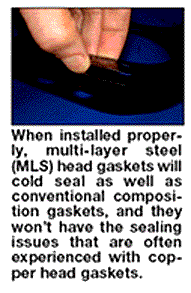
What may be news to some of our readers is that most of the top NASCAR teams are now using MLS head gaskets, as are most Pro Stock drag racers, many circle track racers and even many street performance machines (including turbocharged and nitrous-boosted sport compact cars). Performance MLS head gaskets are now available for most popular engines, including small block/big block Chevys and Fords (including factory racing block versions of these motors), also Chryslers, Pontiacs, Oldsmobiles, and imports such as Honda, Mitsubishi, Nissan, Toyota, VW, etc. Consequently, MLS head gaskets have become the gasket of choice for many forms of racing because they have what it takes to handle the pressure without leaking, blowing out or burning through. More on MLS head gaskets in a minute.
EVOLVING HEAD GASKET DESIGNS
Anyone who has shopped around for high performance head gaskets knows there are a lot of different styles from which to choose. Some performance head gaskets use a traditional composition construction with a soft graphite or non-asbestos facing material on both sides of a solid steel or perforated steel core. The soft outer layer provides conformability for a good cold seal while the steel core provides rigidity and strength. Most have some type of outer coating such as silicone to improve cold sealing, or an anti-stick agent to improve lubricity and make removal easier. Many head gaskets also have raised elastomer sealing beads printed on the surface to concentrate loading in key areas.
Other performance composition head gaskets use a somewhat different approach and sandwich a layer of graphite between two layers of steel. The outer surface is coated with silicone or a similar material to improve cold sealing.
The facing materials used in performance head gaskets may be the same as those in a stock head gasket, or they may use a higher temperature version of a similar non-asbestos material, or graphite. Graphite can handle heat well and has natural lubricity, but it is a soft material and must be handled with care.
Another characteristic that also distinguishes performance head gaskets from ordinary head gaskets is stronger combustion chamber armor. Most use a high grade stainless steel armor which may be stronger and/or thicker than the armor on a stock head gasket. For higher horsepower applications, a stainless steel or copper wire ring may be placed around the combustion chambers inside the combustion armor. This provides added support for the armor, concentrates loading around the cylinders, and helps the gasket maintain a tight seal under high combustion pressures.
Adding a pre-flattened ring around the combustion chamber raises the sealing force to roughly three times that of a standard head gasket, and allows the gasket to withstand combustion pressures from 1,500 to 3,000 psi in engines generating over 1,000 horsepower.
Some performance head gaskets have oversized wire rings around the combustion chambers that act like O-rings to improve sealing. These require machining receiver grooves in the head or block to accommodate the wire.
The point at which an upgrade to some type of high performance head gasket usually becomes necessary is when an engine’s power output approaches two horsepower per cubic inch.
COPPER HEAD GASKETS
For many years, serious racers have considered copper head gaskets to be the hot setup for high horsepower engines. Most top fuel dragsters and funny cars run copper head gaskets because nothing else works. But that doesn’t mean copper head gaskets are the best sealing solution for all types of racing. They aren’t for a variety of reasons. But they do offer certain advantages over conventional head gaskets:
Copper head gaskets are great for extremely high compression ratios (over 14:1), turbocharged or supercharged engines that are running lots of boost pressure (over 15 psi), or engines with nitrous oxide kits that add an extra 150 to 200 or more horsepower.
Copper conducts heat much better than most other metals, which helps disperse and stabilize head and block temperatures. This helps prevent hot spots that may cause detonation, preignition and/or head warpage, and it helps make engine tuning easier. It also reduces the risk of the gasket blowing out or burning through.
Copper has a 25 percent coefficient of elasticity which allows it to stretch before it fails. So if an engine goes into detonation because the fuel mixture leans out, there’s too much spark advance, or there’s too much compression and not enough fuel octane, copper provides an extra margin of safety.
Copper is also strong. The alloys used for copper head gaskets may have a tensile strength of up to 32,000 psi, which is many times that of the facing materials used in conventional performance head gaskets.
And copper gaskets are reusable – at least for a limited number of times. This is a plus in situations where the heads are on and off the block between races, or frequent tear downs are required.
One of the drawbacks of plain copper head gaskets, though, is that they do not seal oil and coolant very well. If the engine does not contain any coolant, coolant leaks are not an issue. But for engines that do run coolant, getting a copper head gasket to cold seal and maintain a seal can be a challenge. The gasket must be coated with some type of sealer, and both mating surfaces must be absolutely smooth, flat and clean.
Though many people think copper is a relatively soft metal, it does not provide much conformability. On one hand, this is a good thing because the gasket doesn’t crush when the head bolts are torqued down. Consequently, the thickness of the gasket remains the same and does not change. On the other hand, the gasket may not conform very well to small indentations and surface irregularities in the head or block. So some type of sealer coating must be applied to both sides of the gasket – unless it comes pre-coated with sealer or has raised elastomer sealing beads printed on its surface. Several companies make coated copper gaskets that reportedly seal as well as any other gasket, and maintain their seal. The gaskets are also reusable provided the sealer isn’t damaged when the gasket is removed.
Copper can be annealed (softened) by heating it in an oven or with a propane torch, and some racers do this to improve conformability. But heating also causes a certain amount of oxidation which may weaken the gasket and increase the risk of it cracking. Some gasket manufacturers do not recommend annealing copper head gaskets. Others say it is okay provided the gasket is not reheated more than three times.
The best way to anneal a copper head gasket is in a controlled environment such as an air-tight vacuum oven. The gasket should only be heated until it is a dark red (about 900° F) and no more. After the gasket has air cooled, the surface needs to be cleaned with a brush or abrasive pad to remove oxide from the surface. The gasket should then be cleaned with brake cleaner or a similar product and allowed to dry before it is recoated with sealer. Also, the sealer must be allowed to dry before the gasket is installed. This may range from 20 minutes to overnight depending on the type of sealer product used. Some aerosol sealers may require multiple coats for best results. RTV silicone also works, and may be applied around coolant openings in the gasket, block or head. But only a thin coating should be used, and it must be allowed to set before the gasket is installed.
If a copper head gasket is accidentally bent during removal, it can be straightened and an-nealed. But if the gasket has kinked, it should be replaced because a kink concentrates stress and work hardens the metal. This increases the risk of cracking and failure. For the same reason, copper head gaskets should not be cleaned by bead blasting because it work hardens the metal. The same goes for hammering the metal.
Copper gaskets are popular with top fuel drag racers because the gaskets are available in a wide range of thicknesses, which can be changed to alter the compression ratio and "tune" the engine to changing track conditions. Different thicknesses can also be used to accommodate different piston and deck clearances. As a rule, every .010" change in the thickness of the head gasket will change the combustion chamber volume about 2.5 cc.
The hot setup today is to minimize quench clearances between the pistons and cylinder heads, and to maximize compression ratios with small combustion chambers. Domed pistons may interfere with the propagation of the flame front, so engine builders may lower the deck surface and/or raise the height of the pistons so they can run flat top pistons. The thickness of the head gasket then becomes critical in controlling clearances and the compression ratio.
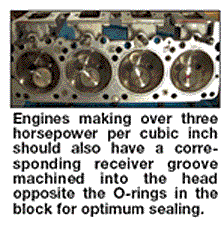
O-RINGS
On most high horsepower engines, copper head gaskets are used with annealed (softened) stainless steel or copper wire o-rings installed on the gasket, or in grooves machined into the block or head. The wire rings help concentrate loading around the cylinders to prevent combustion pressure from blowing past the gasket. The wire rings are typically .041" in diameter, and are placed in a .039" wide x .030" deep groove. The wires should protrude only about about .010" above the surface of the deck, and the thickness of the gasket should be about four times the protrusion of the wires in their grooves, or about .040".
According to one supplier of copper head gaskets, engines that produce over three horsepower per cubic inch should also have a corresponding receiver groove machined into the head opposite the O-rings in the block for optimum sealing. The depth of the receiver grooves should be 75 percent of the O-ring protrusion and the width of the grooves should be 1.5 times that of the wire.
RETORQUING
Though most stock head gaskets do not require retorquing after they have been installed, racing creates an entirely different set of operating conditions. Consequently, many gasket manufacturers recommend retorquing their performance head gaskets after the engine has been warmed up and allowed to cool back down to room temperature. This includes copper head gaskets as well.
The recommended procedure is to start the engine and allow it to reach normal operating temperature. Then shut it off and allow it to cool until it is back down to ambient temperature. If the head gasket is copper, some recommend running the heat cycle with no coolant in the engine (to minimize the risk of a coolant leak). Each head bolt is then loosened about 1/4 to 1/2 turn, and retorqued to specifications in the same sequence they were installed.
Most gasket manufacturers recommend using the OEM torque specifications and tightening sequences, but some racers feel they get a better seal with copper head gaskets if they increase the torque load on the fasteners.
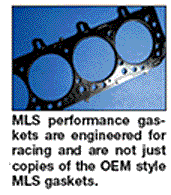
WHY MLS?
The latest alternative to reinforced composite head gaskets and copper head gaskets for performance engines are MLS gaskets. Unlike these other types of gaskets, MLS gaskets use a different strategy to seal the combustion chamber. They typically use 3 to 5 layers of stainless steel to create a spring-like effect that seals the gap between the head and block.
As engine compression, rpm and combustion pressure go up, the cylinder head is pushed away from the block every time the cylinders fire. The movement isn’t enough to be seen with the naked eye, but it can be measured – and it can be enough to break the seal between the head and block with conventional gasket designs. The amount of lift depends on cylinder pressures and how much the head bolts stretch.
To maintain the seal when the head is pushed up and away from the block, the head gasket has to expand as the head lifts. This requires a certain amount of springiness or elasticity that can only be achieved with an MLS head gasket.
The multi-layer construction of MLS head gaskets allows the inner layer(s) to act something like a valve spring. As the head lifts away from the block, the inner layer(s) of the gasket push the outer layers apart to maintain the seal. The spring steel expands and contracts without taking a permanent set or deforming under load, and the gasket maintains its seal. That’s why MLS gaskets have more "vertical recovery" than other types of gaskets and can handle high pressure applications.
In a stock engine, the maximum combustion pressures may only reach about 1,000 psi. But in a performance engine, they can reach 1,500 to 2,200 psi under race conditions, and soar as high as 3,500 psi if the engine goes into detonation. The higher the pressure, the greater the cylinder head separation from the block – and the more the gasket has to expand and contract to maintain its seal.
Aftermarket MLS performance gaskets are engineered for racing and are not just copies of the OEM style MLS gaskets. They have strategically placed sealing beads around the combustion chambers and coolant passages to concentrate clamping loads in the most critical areas. Some MLS gaskets have an additional stainless steel "stopper ring" to further increase sealing pressure around the combustion chambers (such as in Chevy LS1/LS6 engines).
One gasket supplier also has a line of MLS performance gaskets that incorporate a unique "gas-filled ring" around the combustion chambers. The pressure inside the ring is 600 to 700 psi, and increases as the engine heats up to increase the clamping load and combustion seal. Features like these have enabled MLS gaskets to become the gasket of choice for many forms of racing as well as street performance applications.
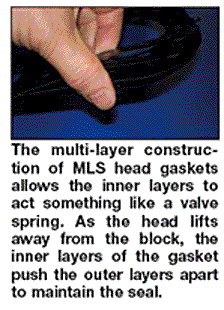
The all-steel construction of MLS gaskets makes them almost bullet-proof under even the most extreme operating conditions. The gaskets also have an exterior "Viton" or polymer coating that helps them cold seal on less than ideal surfaces. Most original equipment MLS require extremely smooth finishes (20 to 30 Ra) to seal. Most performance MLS gaskets require a surface of 50 Ra or less, and some have thicker coatings that can accommodate surface finishes as rough as 60 Ra.
As for reusability, MLS gasket suppliers say MLS gaskets should not be reused because the embossing may not fully recover once the gasket has been through a thermal cycle. But as long as the gasket appears to be in good condition when it is removed, many racers find they can reuse MLS gaskets with no problems. And if the surface coating has a damaged spot or two, it can often be repaired with a light coating of RTV silicone.
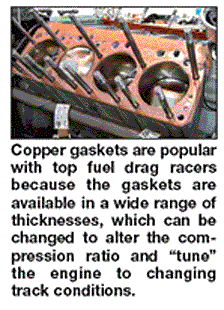
Many racers who used to run copper heads gaskets have switched to MLS because the gaskets hold up just as well and don’t have the sealing or installation issues associated with copper gaskets. The only drawback with MLS gaskets are their price.
The multi-layer construction of MLS head gaskets requires expensive precision tooling, and 3 to 5 layers of stainless steel. Consequently, the jobber price for a performance MLS head gasket for a small block Chevy V8 is around $70 to $75. A steel wire ring composition head gasket, by comparison, might only cost $45, and a stock head gasket only $15.
What’s more, on some applications the cost is even higher because of limited volume or availability. The jobber price for a MLS performance head gasket for a sport compact engine such as Mitsubishi 2.0L, for example, might be as high as $170.
Of course, you only have to buy one for a four cylinder (instead of two for a V8), so some customers might balk at the cost. Even so, considering the durability these gaskets are capable of providing, paying top dollar for a gasket that won’t blow out or fail is more than worth the money. And unlike composition gaskets that cannot be reused, MLS gaskets don’t have to be replaced every time the head comes off the engine.













